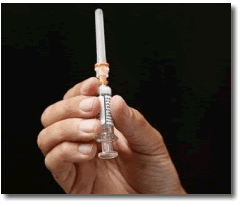Antiretroviral
Zinc Microbicide Gel Protects Monkeys against HIV Infection
 |
 |
 |
 |
 |
 |
 |
| SUMMARY:
A vaginal microbicide gel containing zinc acetate
and a small dose of MIV-150, an investigational
NNRTI, protected female macaque monkeys from infection
with an HIV-related virus for up to 24 hours, according
to a study published this month in the open access
online
journal PLoS ONE. A gel containing zinc
alone provided partial protection. |
|
 |
 |
 |
 |
 |
 |
 |
By
Liz Highleyman
 An
HIV prevention method that can be used by women without cooperation
from their male sexual partners is a key goal of researchers
and advocates worldwide.
An
HIV prevention method that can be used by women without cooperation
from their male sexual partners is a key goal of researchers
and advocates worldwide.
Microbicide
products that act as simple barriers have not proven effective
in studies to date, but the CAPRISA-2
findings reported this past summer demonstrate that microbicides
containing antiretroviral
drugs can be more effective.
However,
using approved drugs that are widely utilized for HIV therapy
as microbicide ingredients is potentially problematic, since
this could lead to drug resistance that limits future treatment
options for people who do become infected.
In
the present study, Jessica Kenney from the Population Council
in New York City and colleagues tested the efficacy of a combination
microbicide gel containing zinc and micro-molar doses of the
novel non-nucleoside reverse transcriptase inhibitor (NNRTI)
MIV-150 in a carrageenan base. Prior studies have shown that
a microbicide containing carrageenan alone (Carraguard) did
not provide significant protection.
The researchers applied vaginal gels containing zinc plus
MIV-150, zinc only, MIV-150 only, or placebo to adult female
macaques every day for 2 weeks; in addition, some monkeys
received gel applications every other day for 4 weeks. The
animals were then "challenged" with non-traumatic
vaginal administration of a hybrid human/monkey immunodeficiency
virus known as SHIV-RT for up to 24 hours after the last gel
application.
Results
 |
Repeated
administration of a combination gel containing 14 mM zinc
acetate and 50 mcM MIV-150 afforded full protection from
HIV infection. |
 |
None
of the 21 monkeys treated with this gel formulation became
infected up to 24 hours after 2 weeks of daily application.
|
 |
Gel
containing zinc acetate alone produced partial protection
(67% at 8-24 hours after application). |
 |
Gel
containing only MIV-150 produced less effective partial
protection (56% at 8 hours, falling to 11% at 24 hours
after the last application). |
 |
A
majority of monkeys (11 out of 14) were still protected
when zinc/MIV-150 combination gel or zinc-only gel was
applied every other day for 4 weeks. |
 |
MIV-150 did not accumulate systemically after repeated
application, and MIV-150-containing gels did not select
for drug-resistant virus. |
Based
on these findings, the study authors concluded, "A combination
MIV-150/zinc acetate gel and a zinc acetate gel provide significant
protection against SHIV-RT infection for up to 24 hours."
"This represents a novel advancement, identifying microbicides
that do not contain antiviral agents used to treat HIV infection
and which can be used repeatedly and independently of coitus,
and underscores the need for future clinical testing of their
safety and ability to prevent HIV transmission in humans,"
they added.
Given that they also provided significant protection, the
researchers recommended that gels containing zinc acetate
alone "should also be considered for further development
and human testing, since they are not expected to promote
drug resistance."
Investigator affiliations; Population Council, New York,
NY; Aaron Diamond AIDS Research Center, Rockefeller University,
New York, NY; Tulane National Primate Research Center, Tulane
University, Covington, LA; AIDS and Cancer Virus Program,
SAIC-Frederick, National Cancer Institute, Frederick, MD.
1/11/11
Reference
J
Kenney, M Aravantinou, R Singer, and others. An Antiretroviral/Zinc
Combination Gel Provides 24 Hours of Complete Protection against
Vaginal SHIV Infection in Macaques. PLoS ONE 6(1):
e15835 (Free
full text). January 2011.
